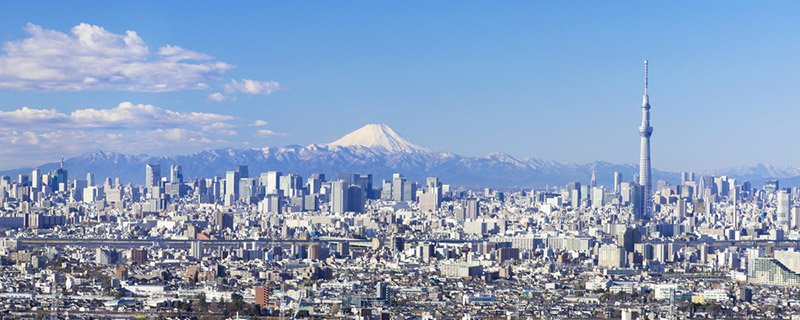Geography

Japan is an archipelagic nation comprising several thousands of islands that lie in the Pacific Ocean, east of the continent of Asia. It is found between 24º- 46º North and 123º- 146º East.
Islands
Japan’s territory consists of 6,852 islands, only 430 of which are inhabited. Its major islands, which are also the largest area-wise, are Hokkaido (the largest and northernmost island), Honshu (the mainland), Kyushu (the third largest) and Shikoku (the fourth largest).
Area
With a total territorial area of 377,915 square kilometres, Japan’s size is similar to Germany, or the state of California in the United States. Its land area is 364,485 square kilometres, while its waters occupy a further 13,430 square kilometres.
Climate
Japan’s climate from north to south varies greatly. While the entire country experiences the four seasons — winter, spring, summer and autumn — its regions differ significantly in regard to temperature and humidity levels throughout the year.
Most of Japan has temperate and subtropical climate, which brings extremely hot and humid summers and mild winters. There is also a rainy season, which occurs during the summer and sees a number of typhoons in some parts of the country.
In Hokkaido, the northernmost island of Japan, and in the regions along the Sea of Japan, the summers are mild and winters tend to be quite cold, with heavy amounts of snowfall.
Terrain
Approximately 73% of Japan is mountainous, with some areas having small deposits of iron, oil, coal and other minerals. The remainder is plains, where growing crops is a common practice, and intermontane basins, where a large portion of the population resides.
Waters
Japan is home to several bodies of water. The Pacific Ocean is on its eastern coast, where many harbours and ports exist, while the Seto Inland Sea links the Sea of Japan and the Pacific Ocean and separates the Kyushu, Shikoku, and Honshu islands. Rivers are relatively short and are generally less than 300 kilometres in length. The longest river is the Shinano River, located between the Nagano and Niigata Prefectures, which is just 367 kilometres long. Lake Biwa, found in northeastern Kyoto, is the biggest freshwater lake in the country. Hot springs or onsen are also scattered over the different regions.
Volcanoes, Earthquakes, and Natural Disasters
Japan lies in the Ring of Fire, a vaguely horseshoe shaped area around much of the Pacific Ocean. This is an area that experiences high levels of volcanic eruptions and earthquakes due to continuous plate movements, volcanic belts, volcanic arcs and ocean trenches. As a result, 10% of the active volcanoes in the world today are located in Japan.
Among the 40 active volcanoes and 148 dormant volcanoes in the country, Mount Fuji, an active volcano and the highest peak in the country, is the most popular.
Other active volcanoes in Japan are the:
- Sakurajima – Located close to Kagoshima in southwestern Kyushu, it is a stratovolcano that experiences several small eruptions every year.
- Mount Asama – Found in Honshu, its most notable eruption was in 1783 when it caused so much devastation that Japan was left in famine for almost five years.
Population
The 2015 census showed Japan’s population stood at around 127.1 million, with Tokyo ranked as the most populous city with around 9 million people and Yokohama a distant second with almost 4 million.
Here are the other cities that made it to the top dozen most populated Japanese cities list as of 2015:
- Osaka – 2.70 million
- Nagoya – 2.30 million
- Sapporo – 1.95 million
- Fukuoka – 1.54 million
- Kobe – 1.54 million
- Kawasaki – 1.48 million
- Kyoto – 1.48 million
- Saitama – 1.27 million
- Hiroshima – 1.19 million
- Sendai – 1.08 million
Regions
Japan consists of eight traditional regions:
- Hokkaido – the northernmost region with a population of 5.5 million and Sapporo as its largest metropolis
- Tohoku – located in northern Honshu, it has a population of 9.3 million and has Sendai as its largest city
- Kanto – has a population of 42.6 million and its largest city is Tokyo
- Chubu – located in central Honshu, it has a population of 21.7 million, with Nagoya as its largest city
- Kansai/Kinki – with 22.8 million people, it consists of Osaka (its largest city) and Japan’s former capital city Kyoto
- Chugoku – is populated by 7.6 million people and its largest city is Hiroshima
- Shikoku – is an island that is inhabited by 4 million people and has Matsuyama as its largest metropolis
- Kyushu – consisting of Northern Kyushu, Southern Kyushu, and Okinawa, its total population is around 14.6 million and its largest city is Fukuoka












